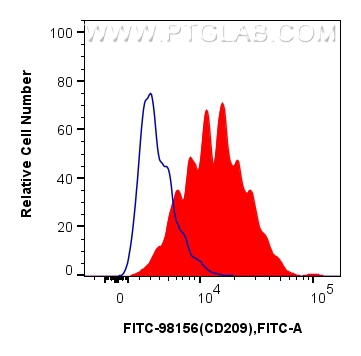验证数据展示
经过测试的应用
| Positive FC detected in | human monocyte-derived immature dendritic cells |
推荐稀释比
| 应用 | 推荐稀释比 |
|---|---|
| This reagent has been pre-titrated and tested for flow cytometric analysis. The suggested use of this reagent is 5 ul per 10^6 cells in a 100 µl suspension or 5 ul per 100 µl of whole blood. | |
| Sample-dependent, Check data in validation data gallery. | |
产品信息
FITC-98156 targets CD209 in FC applications and shows reactivity with human samples.
| 经测试应用 | FC Application Description |
| 经测试反应性 | human |
| 免疫原 | CD209 fusion protein Eg0062 种属同源性预测 |
| 宿主/亚型 | Rabbit / IgG |
| 抗体类别 | Recombinant |
| 产品类型 | Antibody |
| 全称 | CD209 molecule |
| 别名 | 240907A4, CDSIGN, CLEC4L, C-type lectin domain family 4 member L, DC SIGN |
| 计算分子量 | 404 aa, 45.7 kDa |
| GenBank蛋白编号 | BC110615 |
| 基因名称 | CD209 |
| Gene ID (NCBI) | 30835 |
| 偶联类型 | FITC Plus Fluorescent Dye |
| 最大激发/发射波长 | 495 nm / 524 nm |
| 形式 | Liquid |
| 纯化方式 | Protein A purification |
| UNIPROT ID | Q9NNX6 |
| 储存缓冲液 | PBS with 0.09% sodium azide and 0.5% BSA , pH 7.3 |
| 储存条件 | Store at 2-8°C. Avoid exposure to light. Stable for one year after shipment. |
背景介绍
CD209 (DC-SIGN, CLEC4L) is a C-type lectin receptor that is involved in the innate immune system and recognizes numerous evolutionarily divergent pathogens, including bacteria, viruses, and parasites. CD209 is preferentially expressed on dendritic cells (DCs). It mediates transient adhesion of DCs with T cells. It has been reported that CD209 plays a role in capture and transmission of HIV from DC to T cells (PMID: 10721995).
实验方案
| Product Specific Protocols | |
|---|---|
| FC protocol for FITC Plus CD209 antibody FITC-98156 | Download protocol |
| Standard Protocols | |
|---|---|
| Click here to view our Standard Protocols |
